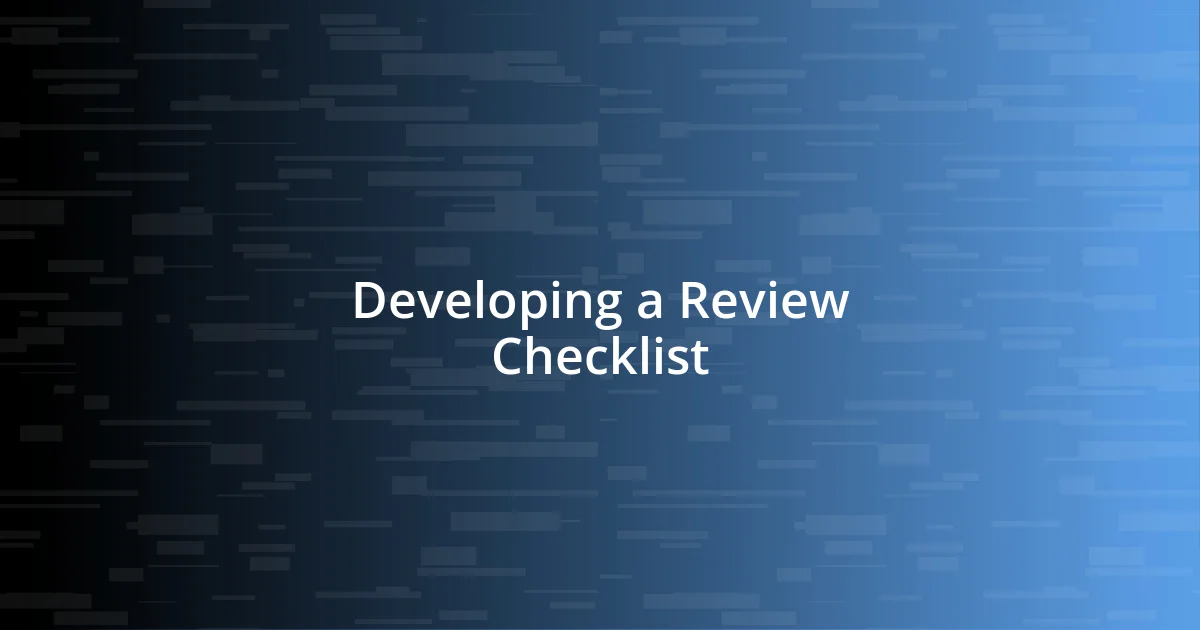Key takeaways:
- Effective streaming series reviews explore storytelling techniques, character development, and thematic relevance, enhancing viewer empathy and understanding.
- Choosing the right series to review involves balancing personal interests, audience relevance, and production quality to create engaging content.
- Gathering feedback and analyzing reader engagement can significantly improve review quality, helping to tailor content that resonates more with the audience.

Understanding Streaming Series Reviews
Understanding streaming series reviews involves recognizing the unique qualities that differentiate them from traditional television reviews. I often find myself diving deep into the storytelling techniques and character development because these elements can greatly affect a viewer’s emotional connection to the series. Have you ever binged a show only to feel utterly hollow after the finale? That’s the impact a strong review can highlight.
A good review should not only summarize the plot but also explore the themes that resonate with audiences. I remember watching a show that tackled mental health—its backdrop and character arcs were so authentic that I couldn’t help but reflect on my own experiences. It made me appreciate how nuanced storytelling can foster empathy among viewers. What emotions did the series evoke in you?
Moreover, understanding context is crucial; it’s not just about the series itself but also how it fits within the larger landscape of streaming content. When I come across a review that places a series in the context of current social issues or compares it with similar shows, I find it immensely helpful. Have you ever read a review that opened your eyes to deeper connections within a series? It’s that kind of analysis that can elevate our viewing experience.

Choosing the Right Series to Review
I’ve found that selecting the right series to review often hinges on my personal interests and the prevailing trends in the streaming world. When I stumble upon a series that sparks excitement or curiosity, I can’t help but dive in. I remember discovering a sci-fi show that unexpectedly blended humor and complex themes; it was refreshing and challenged my usual preferences. What about you? Do you gravitate towards genres you’re already passionate about, or do you like exploring new territory?
Another crucial aspect of choosing a series is audience relevance. I like to consider who I’m writing for and what might resonate with them. If I know my readership enjoys thrillers, I’ll prioritize those shows that not only keep viewers on the edge of their seats but also delve into the intricacies of storytelling. Have you ever noticed how a well-reviewed thriller can generate buzz? It’s this connection to viewer interests that makes a review impactful.
Finally, snags in production quality and direction can also guide my selection process. When I come across a series praised for its cinematography and production values, my interest is piqued. It reminds me of a drama I reviewed that was visually stunning and complemented its gripping narrative perfectly. What series has left a lasting visual impression on you? Balancing personal interest with broader appeal ensures that my reviews are both passionate and insightful.
| Factor | Importance |
|---|---|
| Personal Interest | High |
| Audience Relevance | Moderate |
| Production Quality | High |
| Trend Awareness | Moderate |

Developing a Review Checklist
When I set out to develop a review checklist for streaming series, I focus on essential elements that will guide my evaluation. It’s not just about what I see on the screen; it’s about how each component contributes to the overall experience. I remember once getting tangled in the details of a series’ soundtrack. It seemed minor, but the music enhanced every emotional scene and made me reflect on how pivotal sound design is in storytelling. This experience solidified my belief that a comprehensive checklist must encompass all facets of a series.
Here’s a sample checklist I often refer to:
- Plot Structure: Is the storyline engaging and well-paced? Are there any plot holes?
- Character Development: Are the characters relatable and well-developed? Do they grow throughout the series?
- Themes: What central themes are explored? How effectively are these themes intertwined with the storyline?
- Cinematography: How does the visual presentation enhance storytelling? Is the visual style consistent?
- Sound Design: Does the sound design and score amplify the emotional resonance of the series?
- Audience Impact: What emotions did the series evoke? How does it resonate with contemporary social issues or the audience’s experiences?
This checklist not only grounds my reviews but also protects against overlooking critical aspects that shape a viewer’s experience. Each time I rely on it, I feel more confident that I’m offering a thorough and insightful analysis.

Analyzing Key Elements of Series
When I analyze key elements of a series, I often find that character development grabs my attention first. Characters bring a show to life, and I remember watching a drama where the protagonist’s transformation was so nuanced that it kept me guessing until the very end. This emotional investment made every twist feel personal—doesn’t it just amaze you how a single character can elevate a series?
Themes play a critical role in how a series resonates with its audience. Take, for example, a recent series I reviewed that explored mental health issues with sensitivity and depth. It struck a chord not just with me but with many viewers, sparking discussions that extended beyond the screen. I can’t help but wonder how often we overlook the power of these themes in shaping our understanding and emotional response.
Cinematography is another element I never underestimate. I recall watching a visually stunning series that used color palettes to mirror the characters’ emotional states, creating a powerful storytelling experience. Each frame felt like a work of art, and it left me pondering—how much can visual language speak to us even without words? Engaging with these elements enriches my reviews and adds layers of understanding for my readers.

Writing an Engaging Review
When I sit down to write a review, I always aim to evoke a sense of connection with my readers. I remember penning a review for a compelling sci-fi series that left me breathless, and I focused on the emotional stakes rather than just summarizing the plot. Isn’t it more engaging when a review feels like a conversation about shared experiences rather than just a critique? I’ll often share my reactions to pivotal scenes, such as a shocking twist that made me gasp—those moments are what truly resonate with others.
Describing the atmosphere of a series can elevate a review significantly. I once reviewed a crime thriller with an eerie backdrop that seemed to seep into my skin, creating an unsettling yet fascinating experience. I asked myself, “What was it about the setting that made the tension so palpable?” I found that discussing elements like lighting and soundtrack not only paints a picture but also adds depth, helping readers visualize the series even before they hit play.
Moreover, incorporating quotes from characters can add a memorable touch to a review. I recall a heartwarming exchange between two characters in a romantic drama that perfectly encapsulated its themes of love and vulnerability. By sharing that dialogue, I wasn’t just summarizing a line; I was inviting my readers to feel that moment with me. Engaging reviews spark emotion and reflection, ensuring viewers experience the series richly and personally, just as I did.

Promoting Your Reviews Online
Promoting your reviews online is all about engaging with communities where your audience hangs out. I remember when I first shared a review on a series that completely surprised me. I joined fandom groups on social media and posted my thoughts, leading to vibrant discussions that helped broaden my perspective. Have you ever found that sharing your insights in the right places can ignite a conversation that transcends the review itself?
Utilizing platforms like Twitter and Instagram can really amplify your reach. I often share stunning visuals or memorable quotes from the series along with a link to my review. It’s incredible how a simple image can catch someone’s eye and draw them into my thoughts. When I did this for a recent fantasy series, I noticed an uptick in engagement, sparking conversations around themes and characters that I hadn’t expected—it’s as if those images helped my audience form their own connections to the content.
Don’t overlook the power of collaboration either. I once partnered with fellow reviewers to cross-promote our content, leading to greater visibility for everyone involved. Whether through guest posts on each other’s blogs or co-hosting a discussion on platforms like YouTube, sharing my insights this way not only enriched my reviews but also built relationships with other passionate voices. Have you thought about how wielding the collective influence of a community can elevate your reviews as well?

Gathering Feedback and Improving Reviews
Gathering feedback is an invaluable part of refining my reviews. After posting my thoughts on a recent thriller series, I was pleasantly surprised by the insightful comments from readers who interpreted the plot twists in ways I hadn’t considered. Engaging with this feedback allowed me to deepen my analysis, ensuring my next review reflected a broader perspective. Have you ever felt that a reader’s point of view reshaped your understanding of a series?
I actively seek out constructive criticism, as it helps me improve. For instance, after a review received mixed reactions regarding my summary, I reached out to some readers for their thoughts. Their honest feedback revealed that some preferred a more holistic overview before delving into my personal insights. This experience taught me that tailoring my approach based on audience preferences can significantly enhance the overall reading experience.
In addition to seeking feedback, it’s essential to assess my reviews’ impact. I recently implemented a simple survey after a few reviews, asking readers what they found most engaging. The results were illuminating and helped me realize that my audience enjoys more personal anecdotes and less plot recap. Have you tried conducting surveys or polls to gauge how effective your reviews are? It’s a powerful way to create content that resonates with your readers, ultimately leading to a richer dialogue.














